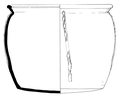Fabric 55 - Worcester-type sandy unglazed ware
Form number
55/03
Manufacture
Hand-made;Wheel-thrown
Type
Rounded jar
Type reference
MPRG 4.01.07
Other type
Cooking pot
Rim description
Everted, thickened
Base description
Sagging
Decoration type
Incised lines and applied strips
Decoration description
A small number of vessels (less than 1%) have incised wavy lines on top of the rim and/or shoulder. Vertical applied strips with thumb-impressions occasionally found on large vessels.
Function
These vessels are cylindrical and generally shorter than they are broad. The rim profile can vary but the basic shape, and presumably the function, remain the same. Almost all sherds found are sooted and smoke blackened and were used for cooking over an open fire.
General distribution
This type is the most common form found in fabric 55 and has been identified in most medieval assemblages in Worcestershire.
Medieval (12th to 14th century)
Jars of this type first appear in the 12th century but are most common in the 13th century. They are less common in the early 14th century and have decreased markedly by the mid to late 14th century when documentary evidence indicates that they were replaced in most households by brass cooking pots.
Jars of this type first appear in the 12th century but are most common in the 13th century. They are less common in the early 14th century and have decreased markedly by the mid to late 14th century when documentary evidence indicates that they were replaced in most households by brass cooking pots.
Notes
There is some variation in profile amongst these vessels with some classed as rounded jar forms and others as inturned jars. In addition, some examples may be squat or shallow and overlap with bowl forms. One example of this form has a pinched spout and several sherds have been observed with drilled holes.

